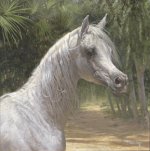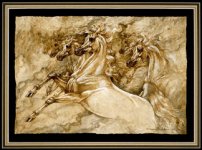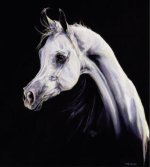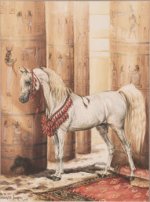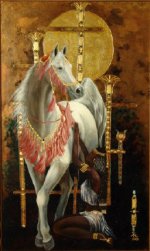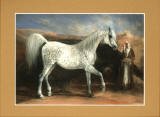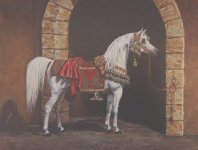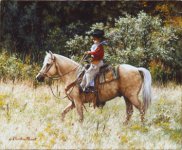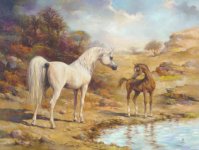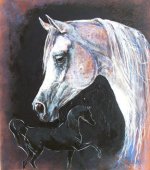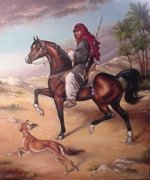sohrab
Active member
Each year at The Egyptian Event, a traditional showcase of the Egyptian Arabian horse has grown into a perfect equine art showcase. Friday evening, June 11th's "The Sixties Revisited" dinner party and art auction will offer original art, donated by many of the world's leading artists. Items to be auctioned will be on display in the covered arena throughout the week. The following pieces are just some of the examples of the fine work represented and available at this year's Event.
Mary Haggard-1
In her own words:
Many Arabian horses have inspired me, but if I had to mention just one, it would be my first horse, Rafaseen, aka “Bean.” Although a horse crazy youngster, I rarely dreamt of horses at night, but if I did, the horse was too small or too weak to ride.
So, I wasn’t surprised when I saw my Arabian “dream horse” for the first time. He was a little over a year old, infested with worms, with an upside down neck, and hips you could hang a hat on. But I also saw the beautiful horse he could be. His eyes were unforgettable: huge, black, and full of mischief and life. In fact, too much mischief for us to handle! Gelding didn’t help much, so we learned how to handle a lively gelding who thought he was a stallion. He enjoyed playing the intimidator: circling, dancing, snorting, and puffing-up as if he were 16-hands, even though he was only 14.2. Yet he would stand perfectly still to have his legs clipped. And he responded to our conversation with little nickers and ‘mumblings.’ In his late teens, he surprised us all by carrying the American flag at the county fair in his Arabian costume.
His was a beauty that not everyone could appreciate, yet he was the classic Arabian, with his white, speckled coat like satin, a wedge-shaped head with small, alert ears, and a fine throat. Prancing with springs in his hooves, arched neck, and tail veiled in white, he would say, ‘Here I am, alive and glad of it!’
Still dancing to the end, Rafaseen passed on in May 2002, at the age of 28. I like to think he lives on through my art. If you see a horse in one of my paintings with a special gleam in his eye, that’s my Bean.
Shary B. Akers-2
In her own words:
Describing how Arabian horses inspire me, is like trying to describe my deepest love and passion. The Arabian horse is truly one of God's greatest artistic gifts of beauty and grace. I started my artistic endeavors at an early age. Mom (an art teacher) kidded, saying as a child, I could always be found behind curtains with my crayons, drawing horses on the wall. Horses were, and always have been, my first and everlasting love.
Oil painting and bronze sculpture have an equal hold on me, one artistic form of expression helping improve the other. The knowledge of anatomy I've obtained from doing 3-dimensional work, aides my 2-dimensional work; just as the knowledge of beautiful line and form for my 2-D work, continually helps to better my 3-D creations.
I'm very proud that both my paintings and bronzes are so well received. My watercolors on Barkpaper, where ethereal images of horses are found and painted from the natural lines and shades of the paper (like seeing horses in clouds), are one of my most unique treatments. I exhibit my work at major horse and art shows around the country, and have participated in the American Academy of Equine Artists juried exhibits.
I owned, bred, and showed Arabian horses for many years. Although I no longer have them, I hope those personal experiences and my love affair with the breed are apparent in my art work, and that it adds a distinct character to it. Of course—I’ll be at the Egyptian Event with bells on! It’s one of my favorite shows in the world, and favorite groups of people!
Three words that describe my work? Unique, heartfelt, and captivating.
Tara Brown-3
In her own words:
Arabian horses don’t move, they dance. They are poetic. I love their eloquence, their fire and faithfulness, their devotion and intelligence. Their history lends itself to many expressions. They are so versatile. They are the perfect breed for equine art. I have owned my purebred gelding for 25 of his 26 years.
I remember as a child, I would draw only horses, even though my mother tried to persuade me to try other subjects. After doing a portrait of a friend’s purebred Arabian stallion, my career took off, and it has taken me on a fabulous journey around the world. I’ve had regular exhibits in Sydney, Melbourne, and Brisbane, and places in between.
I prefer to work in pastels, because it gives me the soft emotive…I love the hues, and the way it blends, and that they can be applied to achieve many effects. My best known works are ‘Timeout’ and ‘In the Night.’ ‘Timeout’ captures a moment in time, when a mare rests between classes, her rider still mounted, before the championship ride. I donated ‘In the Night,’ a study of a mare calling to someone or something, to last year’s art auction. The warm response was unforgettable.
It’s an awesome feeling, to have my work appreciated by The Pyramid Society. Last year, the Egyptian Event was one of the most exhilarating experiences of my life—and I was in Australia! Nonetheless, I couldn’t sleep a wink, and could hardly wait to hear the results. This year will be the same. I am excited to be a part of it.
Three words to describe my art? Alive, emotive, personable.
Margareth Sweirtok-4
Like many equine artists, Margareth Swiertok has been fascinated by horses since childhood. A native of Poland and a graduate of the Art Institute of Czestochowa, she is a versatile artist who works in several media, including pastels, oil on canvas, and watercolor. She also enjoys creating works in a variety of sizes, from small and intimate paintings to large wall murals.
The Arabian horse is a special inspiration to Margareth, and her work depicting this noble breed has garnered acclaim around the world. She takes pride in her realistic portrayals, working diligently to capture the difficult anatomy of the horse, and giving special attention to the details which make her work distinctive. She has had numerous showings in Poland and throughout Europe and has exhibited paintings at such prestigious Arabian horse shows as the Tulip Cup, the European Championships, and the Polish Prestige auction at Janów Podlaski.
Margareth is quick to point out that she prefers her paintings to speak for her, rather than talking about herself. With her paintings found in private collections in the U.S., Canada, France, England, Germany and many Arabian Gulf and Middle Eastern countries, it is obvious that her work indeed speaks to the hearts of many collectors. Margareth has also enjoyed meeting the people around the world who love Arabian horses, and is particularly honored that such discriminating breeders as Shirley and Charlie Watts of Halsdon Arabians, and HRH Princess Alia al Hussein of Jordan have added her work to their fine collections
Inge Manders-5
In her own words:
It’s like great music that moves one to tears. Imagine if you will, sitting astride a mighty Arabian stallion, sleek neck arched, dainty nostrils flaring in an attempt to catch a whiff of the distant desert breeze…my eyes brim with tears because I’ve felt something all powerful, beautiful, and consuming. That’s what inspires me to paint Arabians and other horses.
I have nearly always owned horses, and today have a black, Egyptian-related Arabian stallion named Yogi. I ran Hazelmere Stables and El-Hijr Arabian Stud for ten years, and with 86 horses, painting was a luxury I didn’t have much time for.
I started drawing as soon as I could hold a pencil...always horses on everything—much to the frustration of my teachers. I currently am exhibiting my works in Kwazulu Natal, South Africa, and have shown my work in Johannesburg. I work with oils, combining them with my new-found passion for gold, silver, and copper leaf. I’ve discovered a way to patinate the leaf with a variety of chemicals to create the most wonderful backgrounds for the oil paints.
I wanted my painting for the Auction to reflect the power and beauty of the straight Egyptian Arabian. “In Reverence of Amun-Ra” is painted on masonite board which has been guilded with 50 pure copper leaves, 23 karat gold, and composite gold leaf. It’s highlighted with liquid lead, and embellished with 38 turquoise stones, 23 lapis lazuli, 4 fire opals, and 3 faceted garnets. The painting depicts an Egyptian Nubian girl tending her royal charge. With closed eyes she feels his powerful muscles twitch under his silky coat as he sniffs the balmy gust of wind that carries the sweet scent of the Nile river.
Three words to describe my art? Sumptuous, seductive, and romantic.
Anneliese Muschler-6
In her own words:
Painting is my personal paradise. It allows me to live in my world of dreams, and gives me every imaginable happiness. What fascinates me, and inspires me to use Arabian horses as the subject of my art is their incredible beauty, their charm, and their unique character.
I started creating art as a child, and my favorite subject has always been the Arabian horse. I have always loved them. I owned straight Egyptian Arabian horses, but did not have enough time to enjoy them thoroughly, and to do them justice. I have had many exhibitions internationally, including individual and group exhibitions at several galleries and horse shows in Europe. And I was at the Egyptian Event in 2002, and the Qatar Horse Show in 2004 and 2005. I favor working with delicate chalk pastels or red chalk. But I also enjoy working with oils. I’m probably best known for my portrait of RN Farida.
For the 2005 Egyptian Event Art Auction, I’m going to donate a picture of Ansata Halim Shah. Apart from *Morafic, he is absolutely my favorite horse. I am using pastels because they allow me to underline his delicate features. When I was at the Egyptian Event in 2002, it gave me a lot of pleasure. I hope to be back this year—it is so fascinating! I’m proud and happy to have one of my works of art at the auction.
Three words to describe my art? Committed, passionate, delicate.
Mary Haggard-1
In her own words:
Many Arabian horses have inspired me, but if I had to mention just one, it would be my first horse, Rafaseen, aka “Bean.” Although a horse crazy youngster, I rarely dreamt of horses at night, but if I did, the horse was too small or too weak to ride.
So, I wasn’t surprised when I saw my Arabian “dream horse” for the first time. He was a little over a year old, infested with worms, with an upside down neck, and hips you could hang a hat on. But I also saw the beautiful horse he could be. His eyes were unforgettable: huge, black, and full of mischief and life. In fact, too much mischief for us to handle! Gelding didn’t help much, so we learned how to handle a lively gelding who thought he was a stallion. He enjoyed playing the intimidator: circling, dancing, snorting, and puffing-up as if he were 16-hands, even though he was only 14.2. Yet he would stand perfectly still to have his legs clipped. And he responded to our conversation with little nickers and ‘mumblings.’ In his late teens, he surprised us all by carrying the American flag at the county fair in his Arabian costume.
His was a beauty that not everyone could appreciate, yet he was the classic Arabian, with his white, speckled coat like satin, a wedge-shaped head with small, alert ears, and a fine throat. Prancing with springs in his hooves, arched neck, and tail veiled in white, he would say, ‘Here I am, alive and glad of it!’
Still dancing to the end, Rafaseen passed on in May 2002, at the age of 28. I like to think he lives on through my art. If you see a horse in one of my paintings with a special gleam in his eye, that’s my Bean.
Shary B. Akers-2
In her own words:
Describing how Arabian horses inspire me, is like trying to describe my deepest love and passion. The Arabian horse is truly one of God's greatest artistic gifts of beauty and grace. I started my artistic endeavors at an early age. Mom (an art teacher) kidded, saying as a child, I could always be found behind curtains with my crayons, drawing horses on the wall. Horses were, and always have been, my first and everlasting love.
Oil painting and bronze sculpture have an equal hold on me, one artistic form of expression helping improve the other. The knowledge of anatomy I've obtained from doing 3-dimensional work, aides my 2-dimensional work; just as the knowledge of beautiful line and form for my 2-D work, continually helps to better my 3-D creations.
I'm very proud that both my paintings and bronzes are so well received. My watercolors on Barkpaper, where ethereal images of horses are found and painted from the natural lines and shades of the paper (like seeing horses in clouds), are one of my most unique treatments. I exhibit my work at major horse and art shows around the country, and have participated in the American Academy of Equine Artists juried exhibits.
I owned, bred, and showed Arabian horses for many years. Although I no longer have them, I hope those personal experiences and my love affair with the breed are apparent in my art work, and that it adds a distinct character to it. Of course—I’ll be at the Egyptian Event with bells on! It’s one of my favorite shows in the world, and favorite groups of people!
Three words that describe my work? Unique, heartfelt, and captivating.
Tara Brown-3
In her own words:
Arabian horses don’t move, they dance. They are poetic. I love their eloquence, their fire and faithfulness, their devotion and intelligence. Their history lends itself to many expressions. They are so versatile. They are the perfect breed for equine art. I have owned my purebred gelding for 25 of his 26 years.
I remember as a child, I would draw only horses, even though my mother tried to persuade me to try other subjects. After doing a portrait of a friend’s purebred Arabian stallion, my career took off, and it has taken me on a fabulous journey around the world. I’ve had regular exhibits in Sydney, Melbourne, and Brisbane, and places in between.
I prefer to work in pastels, because it gives me the soft emotive…I love the hues, and the way it blends, and that they can be applied to achieve many effects. My best known works are ‘Timeout’ and ‘In the Night.’ ‘Timeout’ captures a moment in time, when a mare rests between classes, her rider still mounted, before the championship ride. I donated ‘In the Night,’ a study of a mare calling to someone or something, to last year’s art auction. The warm response was unforgettable.
It’s an awesome feeling, to have my work appreciated by The Pyramid Society. Last year, the Egyptian Event was one of the most exhilarating experiences of my life—and I was in Australia! Nonetheless, I couldn’t sleep a wink, and could hardly wait to hear the results. This year will be the same. I am excited to be a part of it.
Three words to describe my art? Alive, emotive, personable.
Margareth Sweirtok-4
Like many equine artists, Margareth Swiertok has been fascinated by horses since childhood. A native of Poland and a graduate of the Art Institute of Czestochowa, she is a versatile artist who works in several media, including pastels, oil on canvas, and watercolor. She also enjoys creating works in a variety of sizes, from small and intimate paintings to large wall murals.
The Arabian horse is a special inspiration to Margareth, and her work depicting this noble breed has garnered acclaim around the world. She takes pride in her realistic portrayals, working diligently to capture the difficult anatomy of the horse, and giving special attention to the details which make her work distinctive. She has had numerous showings in Poland and throughout Europe and has exhibited paintings at such prestigious Arabian horse shows as the Tulip Cup, the European Championships, and the Polish Prestige auction at Janów Podlaski.
Margareth is quick to point out that she prefers her paintings to speak for her, rather than talking about herself. With her paintings found in private collections in the U.S., Canada, France, England, Germany and many Arabian Gulf and Middle Eastern countries, it is obvious that her work indeed speaks to the hearts of many collectors. Margareth has also enjoyed meeting the people around the world who love Arabian horses, and is particularly honored that such discriminating breeders as Shirley and Charlie Watts of Halsdon Arabians, and HRH Princess Alia al Hussein of Jordan have added her work to their fine collections
Inge Manders-5
In her own words:
It’s like great music that moves one to tears. Imagine if you will, sitting astride a mighty Arabian stallion, sleek neck arched, dainty nostrils flaring in an attempt to catch a whiff of the distant desert breeze…my eyes brim with tears because I’ve felt something all powerful, beautiful, and consuming. That’s what inspires me to paint Arabians and other horses.
I have nearly always owned horses, and today have a black, Egyptian-related Arabian stallion named Yogi. I ran Hazelmere Stables and El-Hijr Arabian Stud for ten years, and with 86 horses, painting was a luxury I didn’t have much time for.
I started drawing as soon as I could hold a pencil...always horses on everything—much to the frustration of my teachers. I currently am exhibiting my works in Kwazulu Natal, South Africa, and have shown my work in Johannesburg. I work with oils, combining them with my new-found passion for gold, silver, and copper leaf. I’ve discovered a way to patinate the leaf with a variety of chemicals to create the most wonderful backgrounds for the oil paints.
I wanted my painting for the Auction to reflect the power and beauty of the straight Egyptian Arabian. “In Reverence of Amun-Ra” is painted on masonite board which has been guilded with 50 pure copper leaves, 23 karat gold, and composite gold leaf. It’s highlighted with liquid lead, and embellished with 38 turquoise stones, 23 lapis lazuli, 4 fire opals, and 3 faceted garnets. The painting depicts an Egyptian Nubian girl tending her royal charge. With closed eyes she feels his powerful muscles twitch under his silky coat as he sniffs the balmy gust of wind that carries the sweet scent of the Nile river.
Three words to describe my art? Sumptuous, seductive, and romantic.
Anneliese Muschler-6
In her own words:
Painting is my personal paradise. It allows me to live in my world of dreams, and gives me every imaginable happiness. What fascinates me, and inspires me to use Arabian horses as the subject of my art is their incredible beauty, their charm, and their unique character.
I started creating art as a child, and my favorite subject has always been the Arabian horse. I have always loved them. I owned straight Egyptian Arabian horses, but did not have enough time to enjoy them thoroughly, and to do them justice. I have had many exhibitions internationally, including individual and group exhibitions at several galleries and horse shows in Europe. And I was at the Egyptian Event in 2002, and the Qatar Horse Show in 2004 and 2005. I favor working with delicate chalk pastels or red chalk. But I also enjoy working with oils. I’m probably best known for my portrait of RN Farida.
For the 2005 Egyptian Event Art Auction, I’m going to donate a picture of Ansata Halim Shah. Apart from *Morafic, he is absolutely my favorite horse. I am using pastels because they allow me to underline his delicate features. When I was at the Egyptian Event in 2002, it gave me a lot of pleasure. I hope to be back this year—it is so fascinating! I’m proud and happy to have one of my works of art at the auction.
Three words to describe my art? Committed, passionate, delicate.

